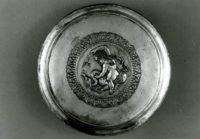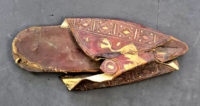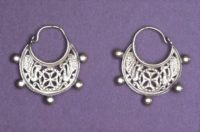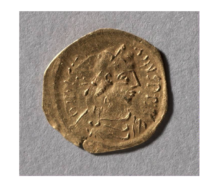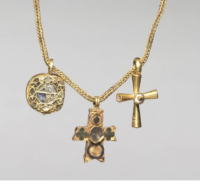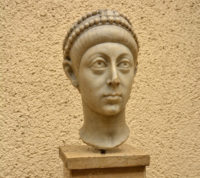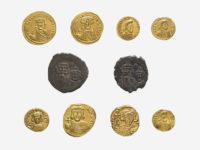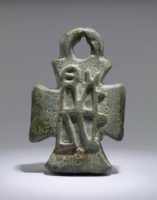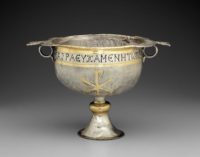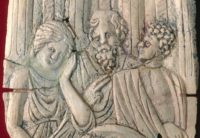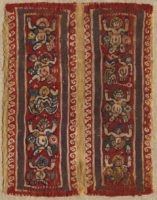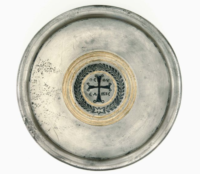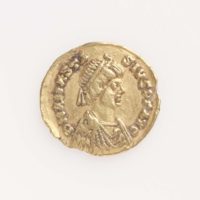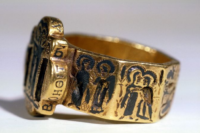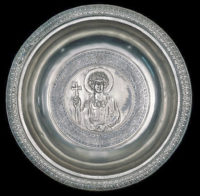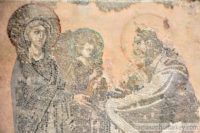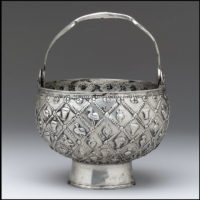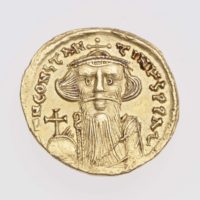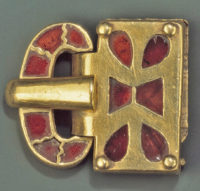British Museum
Silver Dish; Period: Early Byzantine. 6th.c.(late) on a shallow foot; the centre decorated with E...
British Museum
Slipper; leather; with pointed toe and thick sole with gilt borders on the upper part and the fig...
Istanbul Archaeological Museum
Sarcophagus – from the imperial cemetery beside the Church of the Holy Apostles. Period: Ea...
British Museum
Pair of Loop Earrings; Materials: Gold. Period: Early Byzantine. 6thC-7thC. Subjects: Cross, Peac...
Cleveland Art Museum
Half Tremissis of Justinian I, 527-565, Minted in: Constantinople. Material: Gold. Diameter: w. 1...
Cleveland Museum of Art
Chain with Pendant and Two Crosses, Materials: Gold with enamel and glass. Period: Early Byzantin...
Istanbul Archaeological Museum
Bust of Emperor Arcadius, Period: Early Byzantine circa: late 4th. century. Made in/Findspot: Con...
British Museum
Coins; Ruler: Constantine IV; Period: Early Byzantine Period; circa: 654-685; Minted in: Sicily, ...
British Museum
Counterpoise weight, Period: Early Byzantine, circa: 6th c. Material: Bronze. British Museum is c...
Museum of Fine Arts, Boston
Silver Chalice, Period: Early Byzantine, circa: 6th century A.D. Dimensions: Height (max.): 18 cm...
Museum of Fine Arts, Boston
Relief based on story of Achilles receiving his armor on the island of Skyros. Period: Early Byza...
The Cleveland Art Museum
Fragment, Sleeve Ornament of a Tunic, Period: Early Byzantine, circa: 5th – 7th century. Ma...
Dumbarton Oaks Museum
Plate with Cross and Greek Inscription ‘Hope of God’, Period: Early Byzantine, 7th ce...
museum of fine arts boston
Tremissis of Theodoric in the name of Anastasius I, Period: Early Byzantine; circa: 491–518 A.D. ...
Dumbarton Oaks Museum
Octagonal Marriage Ring with Holy Site Scenes, Period: Early Byzantine, circa: 7th Century. Mate...
British Museum
Bowl; circular medallion with half-figure of a nimbed saint, St Sergios. Period: Early Byzantine;...
Istanbul Archaeological Museum
Mosaic Panel. Period: Early Byzantine; circa: Late 6th – early 7th century. Findspot: Ista...
The Metropolitan Museum of Art
Silver Bucket, Period: Early Byzantine circa: 600s. Made in Tirana, Modern Albania. (Found in Vra...
Museum of Fine Arts, Boston
Solidus of Constantinus III, Mint: Constantinople, Period: A.D. 641–668, Early Byzantine. Materia...
The Met Fifth Avenue
Buckle with Garnets. Period: Early Byzantine; circa:400–500 A.D. Material: gold. Made in: Constan...


